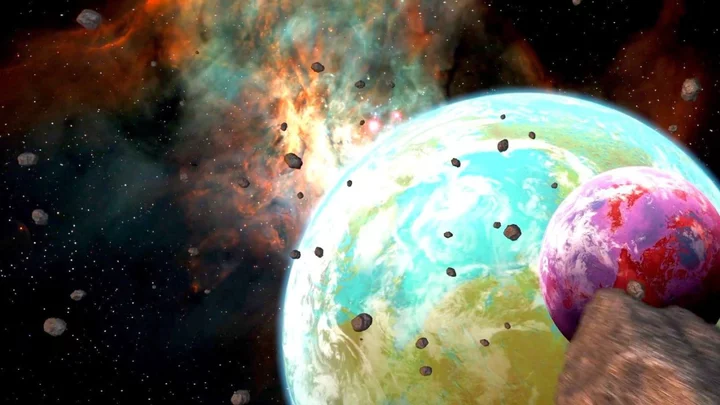
Scientists now say finding alien life in the universe is 'only a matter of time'
Scientists are optimistic about the possibility of finding life on other planets. Nasa's James Webb Space Telescope (JWST) found a possible sign of a gas that, on Earth, is produced by simple marine organisms. It was detected this month in the atmosphere of a planet named K2-18b, which is 120 light years away. The planet is in what astronomers call ''the Goldilocks zone' - the right distance away from its star for the surface temperature to be neither too hot nor too cold, but just right for there to be liquid water, which is essential to support life. The team expects to know in a year's time whether the hints are confirmed or have gone away. "We live in an infinite Universe, with infinite stars and planets. And it's been obvious to many of us that we can't be the only intelligent life out there," Prof Catherine Heymans, Scotland's Astronomer Royal told the BBC. "We now have the technology and the capability to answer the question of whether we are alone in the cosmos." Prof Nikku Madhusudhan of the Institute of Astronomy at Cambridge University, who led the study, told the BBC that if the hints are confirmed "it would radically change the way we think about the search for life". "If we find signs of life on the very first planet we study, it will raise the possibility that life is common in the Universe." He predicted that within five years there will be "a major transformation" in our understanding of life in the Universe. If his team don't find life signs on K2-18b, they have 10 more Goldilocks planets on their list to study - and possibly many more after that. Even finding nothing would "provide important insights into the possibility of life on such planets", he said. Meanwhile there are other separate projects all looking for signs of life in the universe. Pretty exciting. Sign up to our free Indy100 weekly newsletter Have your say in our news democracy. Click the upvote icon at the top of the page to help raise this article through the indy100 rankings.
2023-09-30 23:28
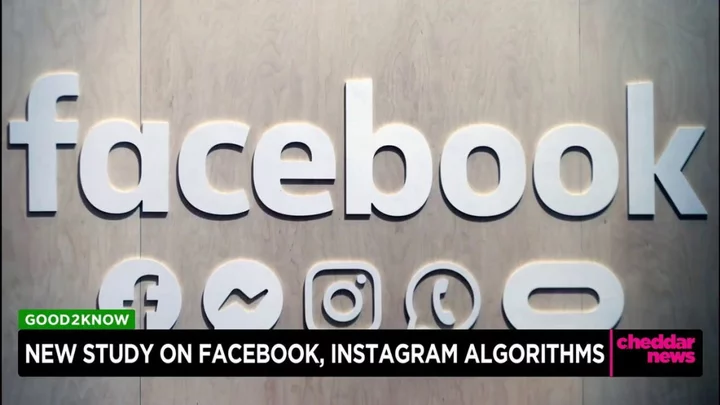
Has Facebook changed its blue logo?
Facebook is known for its recognisable 'f' logo using the colours light navy blue and white - however, people can't help but notice something different. Some have noticed that once logged into their account there has been a slight tweak to the blue colour they have been familiar with in recent years. The new blue announced by the social media platform is richer, bold and darker in a move which is "Redefining Facebook’s brand identity." “We’re excited to launch the first phase of a refreshed identity system for Facebook, with a focus on fostering effortless, self-initiated exploration and connection across every touchpoint," the announcement read. There were three "key drivers" in regards to the brand design update which include: "Elevate the most iconic elements of our brand to create a distinctive, refreshed Facebook." The second is to "Unify how the Facebook brand comes to life across product-to-marketing experiences." On the topic of blue tone change, this came from wanting to "create an expansive set of colours — anchored in our core blue — that is comprehensive and vibrant, and also designed to be more accessible for people." Of course, Facebook users couldn't help but notice the colour change and took to social media to question if their eyes were deceiving them. Elsewhere, a Mark Zuckerberg product has been deemed the 'cringiest AI of all time'. Sign up to our free Indy100 weekly newsletter Have your say in our news democracy. Click the upvote icon at the top of the page to help raise this article through the indy100 rankings.
2023-09-29 22:18
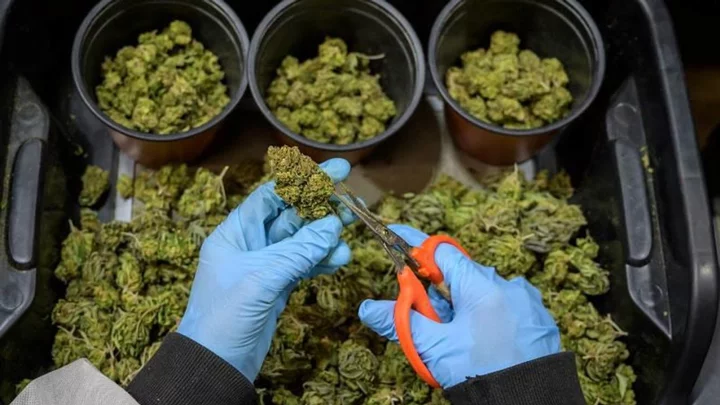
This is what cannabis does to your body minute by minute
Debates around the legalisation of cannabis have existed for years, with cannabis currently considered a class B drug in the UK. This means you can be prosecuted with up to five years in prison or a fine of up to £2,500 if you're found in possession of it. Different factors can affect how cannabis will affect you. For example, smoking weed will meant the effects kick in a lot faster than if you were to take an edible. Age, height, weight, and tolerance levels can also change how you experience the effects of cannabis. However, here's a quick breakdown of how cannabis effects you, minute-by-minute: It can take anywhere between 2 and 10 minutes for the effects of smoking weed to kick in. However, according to Healthline if you take an edible, you could be waiting for half an hour to two hours before you start to feel the effects. One of the first effects you'll begin to feel is an increase in pulse rate. WebMD suggests that your heart rate can rise by 20 to 50 bears from the normal rate of 50 to 70 bears per minute. Your heart rate can stay at the increased rate for up to 3 hours after you use cannabis. Next, the blood vessels in your eyes will dilate, likely turning your eyes red as a result. If you smoked the cannabis, the THC (the main psychoactive compound in cannabis) will be fully absorbed into your blood around the 20-minute mark. However, if you took an edible this takes longer due to the THC needing to be absorbed by your liver. The body's neural chemistry can be altered once the THC is fully settled in your system, stimulating the part of your brain that responds to pleasure. This releases dopamine, resulting in the relaxed state often associated with smoking weed. However, some individuals can also feel anxious and have a panic attack as a result. Around this time is when you'll be hit with the 'munchies'. This is because the THC finds the olfactory bulb (which impacts your sense of taste and smell) in you brain, and can convince you that you're hungry, even if you're not. Roughly 30-minutes in is when the effects reach its peak, lasting up to five or six hours. You may begin to feel sleepy or confused, as well as getting the giggles. Depending on the strain of THC used, these effects can last longer, resulting in lasting impaired judgement. Although the effects mostly wear off within a few hours, traces of cannabis can still be prevalent in a urine test two or three days later. Sign up to our free Indy100 weekly newsletter Have your say in our news democracy. Click the upvote icon at the top of the page to help raise this article through the indy100 rankings.
2023-09-29 20:18

Mark Zuckerberg's latest AI product has been deemed 'cringiest AI of all time'
Mark Zuckerberg, CEO of Meta, revealed its latest AI product containing quite a few familiar faces, but people are unimpressed. On Wednesday at Meta's Connect conference, Zuckerberg unveiled Meta's new AI assistant at its headquarters in Menlo Park, California. The digital assistant has drawn comparisons to ChatGPT, where the program generates in-depth and detailed answers to text queries. What makes it different from other AI assistants, however, is that the assistants have faces of celebrities such as Paris Hilton, Kendall Jenner, and Mr. Beast. The various celebrities partnered with Meta to introduce its "cast of characters". For example, Billie - portrayed by Kendall Jenner - is described as your "No-BS, ride-or-die companion". Roy Choi, a Korean-American chef, plays Max, a "seasoned sous chef for culinary tips and tricks". Each character has also been given their own profile on Instagram and Facebook. Zuckerberg posted the announcement in a video to his Instagram and Facebook profiles, involving him and his family displaying their poor acting skills, as well as Kendall Jenner, Tom Brady, Charli D'Amelio, Snoop Dogg, and Dwayne Wade as their AI assistant characters. But whilst Zuckerberg seemed impressed with the new product, most viewers did not share the same sentiments. Host of Corporate Gossip podcast Becca Platsky posted her reaction to the announcement video, calling it the "cringiest AI of all time". "There's something this product gets so wrong about the way people interact with influencers," Platsky says. "And one thing is influencer snark. That drives a lot of engagement to real life influencers, but nobody's gonna snark on a robot!" She also said, "I'm also not sure how many people are going to want to give Kendall Jenner more money for doing less work." Comments under Platsky's TikTok overwhelmingly agreed. Some called it "embarrassing" whilst another user said it felt "like an SNL skit." "I feel like they think we care about celebrities more than we actually do," commented another user. The criticism didn't stop there though, with many commenting under Zuckerberg's announcement letting him now their thoughts. One user called it "depressing" and said "adding more AI to talk to on [an] everyday basis, this is just loneliness amplified." Another gave Zuckerberg the advice to "fire everyone in your staff that failed to tell you how monumentally stupid this video is." Adding, "who the hell needs to chat to AI friends that look like celebrities?" Sign up to our free Indy100 weekly newsletter Have your say in our news democracy. Click the upvote icon at the top of the page to help raise this article through the indy100 rankings.
2023-09-29 19:15
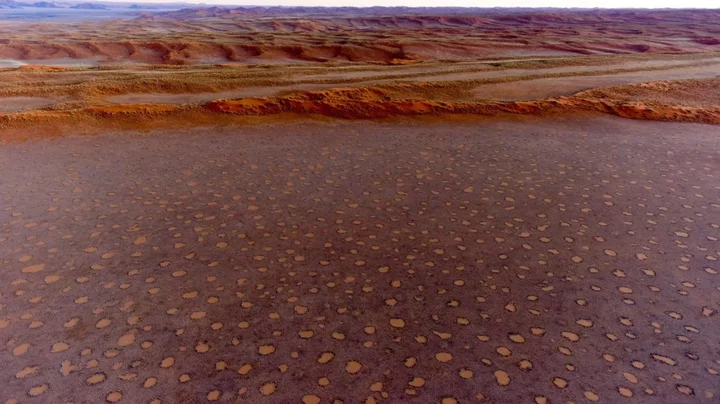
Mysterious fairy circles are increasing across the world and scientists are baffled
A natural phenomenon consisting of polka-dot-style formations has been cropping up around the world, and scientists are baffled as to why. The circular-shaped patches of ground have been seen in deserts in Australia and Namibia but now experts believe they are more widespread than originally thought. Known as “fairy circles”, there are now 263 known sites across the globe where they can be found, according to new research published in the journal Proceedings of the National Academy of Sciences (PNAS). They have been documented in 15 countries, across three continents, including the Sahel region of Africa, Madagascar, and in Middle-West Asia. And yet, despite the spread of these anomalies, scientists are still none the wiser about how they actually form. A team led by environmental scientist Emilio Guirado, of the University of Alicante in Spain, explained in their paper on the "intriguing" phenomenon: “We conducted a global and systematic assessment of fairy circle-like vegetation patterns and discovered hundreds of [fairy-circle]-like locations on three continents. “Our study provides insights into the ecology and biogeography of these fascinating vegetation patterns and the first atlas of their global distribution.” The mysterious circles appear in desert regions and can be as wide as 12 metres (39 feet) in diameter. They are almost always spaced out and rarely connect or overlap with one another. Several theories have been put forward as to what causes them, including, tiny insects, termites, and plant toxins. But, none have been accompanied by any significant evidence and some have been debunked completely. One significant factor limiting their study is they are often found in places that are difficult to access and are inhospitable. Locating the 263 different sites of “fairy circles” involved analysing high-resolution satellite imagery. Guirado and his team wrote in their paper: “[The sites] include those already identified in Namibia and Western Australia, as well as areas never described before, including the Sahel, Western Sahara, Horn of Africa, Madagascar, Southwest Asia, or Central and Southwest Australia. “By doing so, our study provides a global atlas of areas showing FC-like vegetation patterns and expands the known existence of this vegetation type to new countries and continents.” The team hopes that locating new sites will enable them to find common traits that may point towards their cause. Sign up to our free Indy100 weekly newsletter Have your say in our news democracy. Click the upvote icon at the top of the page to help raise this article through the indy100 rankings.
2023-09-29 16:21
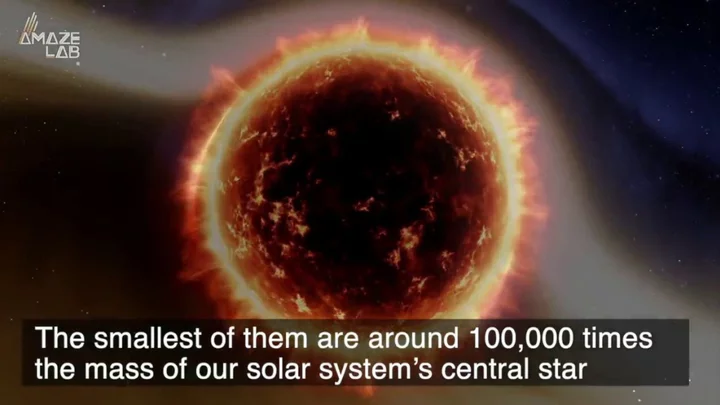
Scientists confirm that the most iconic black hole in the universe is spinning, in major new discovery
Scientists have confirmed that the first black hole to ever be captured on camera is spinning in a major new discovery. The famous doughnut-shaped M87* black hole, 6.5 billion times more massive than the sun, first drew people’s attention in 2019 for becoming the first void to be pictured. Now, it has been confirmed that the M87* black hole is spinning, but experts have yet to determine just how fast. The announcement was made on 27 September. M87* has been observed for the last two decades via a network of radio telescopes. It is located in the Messier 87 (M87) galaxy, which is around 55 million light-years away from Earth in the Virgo constellation. The instruments monitoring the black hole have observed a powerful jet of radiation and particles being expelled from its poles. According to research, the relativistic jets appeared to be on a kind of pendulum that swings every 11 years, observed over decades. Experts believe this is caused by interactions between gravitational interactions between the black hole and the material making up the disk around it. They say this provides “unequivocal evidence” that the black hole is spinning. Cui Yuzhu, a researcher at Zhejiang Lab in China and the study’s lead author explained in a statement: “We are thrilled by this significant finding,” adding, “Since the misalignment between the black hole and the disk is relatively small and the precession period is around 11 years, accumulating high-resolution data tracing M87’s structure over two decades and thorough analysis are essential to obtain this achievement.” Their findings matched with computer simulations, confirming that the jets emitting from the black hole change direction by around 10 degrees every 11 years. Sign up to our free Indy100 weekly newsletter Have your say in our news democracy. Click the upvote icon at the top of the page to help raise this article through the indy100 rankings.
2023-09-28 20:15

Time-lapse that took 20 years to make shows legendary stellar explosion
Scientists have spent 20 years putting together time-lapse footage offering a stunning window into the past. Two decades of data taken from NASA’s Chandra X-ray Observatory were used by astronomers to create a video of a stellar eruption that actually occurred 180 years ago. Observations from Chandra, taken in 1999, 2003, 2009, 2014 and 2020 were all used, in combination with data from ESA’s XMM-Newton spacecraft. With the combined data, experts were able to capture the stellar explosion, known as Eta Carinae. Eta Carinae is a famous star system containing two large stars, one of which is around 90 times larger than the Sun, while the other is around 30 times as large. The “Great Eruption” from Eta Carinae is believed to be the result of the merging of two stars that were originally part of a three-star system. Eta Carinae Time-Lapse, Chandra X-ray Observatory www.youtube.com It first took place in the mid-19th century and the aftermath is still continuing to be observed today. New footage shows how the explosion has expanded into space with staggering speeds of up to 4.5 million miles per hour. In a statement, NASA officials explained: “During this event, Eta Carinae ejected between 10 and 45 times the mass of the sun. This material became a dense pair of spherical clouds of gas, now called the Homunculus Nebula, on opposite sides of the two stars.” The Homunculus Nebula is the blue cloud visible in the video, while the growing bright orange ring shows how X-ray emissions have grown and expanded over time. “The new movie of Chandra, plus a deep, summed image generated by adding the data together, reveal important hints about Eta Carinae’s volatile history,” the statement read. “This includes the rapid expansion of the ring, and a previously-unknown faint shell of X-rays outside it.” Sign up to our free Indy100 weekly newsletter Have your say in our news democracy. Click the upvote icon at the top of the page to help raise this article through the indy100 rankings.
2023-09-28 18:52
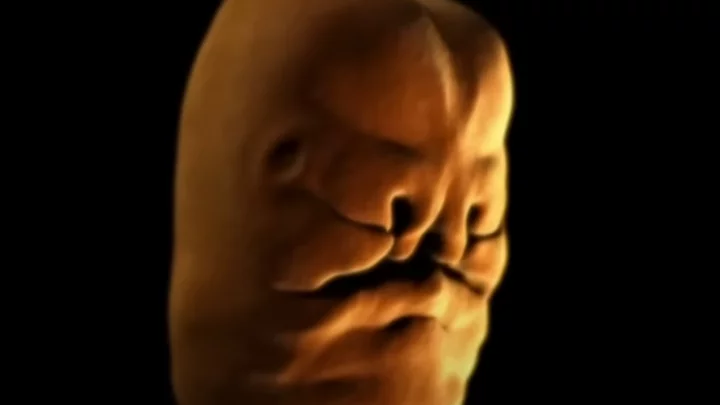
Video showing how babies' faces form is giving people nightmares
The human body is an extraordinary thing – and now, one video is proving just that, while simultaneously giving people nightmares. Childbirth is often regarded as one of nature's most incredible events, but have you ever questioned how a baby's face develops while in the womb? Neither have we. But thanks to the BBC, people are divided about how "beautiful" the process actually is. The simulation shows how the baby's face starts with the philtrum, the area between the bottom of your nose and upper lip. During the episode of Inside the Human Body: Creation, Michael Mosley points out: "Down the centuries, biologists have wondered why every face has this particular feature. What we now know is it is the place where the puzzle that is the human face finally all comes together." The footage then recreates a baby's facial development via an animation, which begins with two holes at the top of the head. It appears as though the features then start to merge, though this is the baby's nostrils. (Fast-forward 32 seconds in to the below video to watch:) Face Development in the Womb - Inside the Human Body: Creation - BBC One www.youtube.com "We've taken data from scans of a developing embryo so we're able to show you for the very first time how our faces don't just grow, but fit together like a puzzle," Mosley continues. "The three main sections of the puzzle meet in the middle of your top lip, creating the groove that is your philtrum." He continues: "This whole amazing process, the bits coming together to produce a recognisable human face, happens in the womb between two and three months. "If it doesn't happen then, it never will." The snippet understandably garnered a mixed response, with one viewer writing: "That was so creepy yet amazing..." Another joked: "Makes me feel better that Brad Pitt and Tom Cruise once looked like space aliens." And a third quipped: "Thank you for the enlightening information and the skin-curdling nightmares." Sign up for our free Indy100 weekly newsletter Have your say in our news democracy. Click the upvote icon at the top of the page to help raise this article through the indy100 rankings.
2023-09-28 18:21

People are just learning Google's original name – and thanking god that it was changed
A world without Google would almost be akin to a world without water or air. Indeed, the internet behemoth’s power is so great that it’s even become its own verb. And sure, there are other search engines, but when have you ever heard someone say: “Let me just Bing that”? Yet, it turns out the iconic tech company could have had a very different fate had it stuck to its original name. That’s right, Google hasn’t always been Google. And at its inception back in 1996, it had a somewhat more risqué title. It was called… BackRub. Yep, BackRub. According to Standford University computer scientist David Koller, who wrote about the brand’s genesis back in 2004, founders Larry Page and Sergey Brin came up with the search engine's first name as a nod to its analysis of the web’s “back links”. However, a year after BackRub was born, Page and his officemates – including fellow graduate students Sean Anderson, Tamara Munzner, and Lucas Pereira – discussed a number of possible alternatives to the massage-evoking moniker. According to Koller, the final, fateful brainstorming session occurred one day in September of that year. “Sean and Larry were in their office, using the whiteboard, trying to think up a good name - something that related to the indexing of an immense amount of data,” he recalled. “Sean verbally suggested the word ‘googolplex,’, and Larry responded verbally with the shortened form, ‘googol’ (both words refer to specific large numbers). “ Anderson then searched the Internet domain name registry database to see if the newly suggested name was still available to use. But, since “Sean is not an infallible speller”, “he made the mistake of searching for the name spelt as ‘google.com,’ which he found to be available,” Koller continued. “Larry liked the name, and within hours he took the step of registering the name ‘google.com’ for himself and Sergey.” And the rest, as they say, is history. Sill, 25 years on from that simple domain name registration that would go on to change the world, people have shared their bewilderment that “BackRub” could have become a household name. “I could die without knowing that this was Google's old name,” one X/Twitter user commented. “What were they smoking back in 90s??” asked another. Meanwhile, a third responded with what we’re all now thinking: “Tbh I need a backrub.” At least the tech titans can now give themselves a pat on the back for a job well done with “Google”. Sign up for our free Indy100 weekly newsletter Have your say in our news democracy. Click the upvote icon at the top of the page to help raise this article through the indy100 rankings.
2023-09-28 16:49

Sushi could secretly be spreading antibiotic resistance
Antibiotic-resistant bacteria are an increasing area of concern for health experts and scientists are concerned that the popular food sushi could be spreading it. Researchers at the Norwegian University of Science and Technology were interested in looking at the health implications of sushi, which is considered pretty standard fare in the country. Dr. Hyejeong Lee, who recently completed her PhD at the Department of Biotechnology and Food Science at NTNU, investigated different varieties of Aeromonas bacteria in seafood products that aren’t processed in a way that reduces bacteria, such as sashimi (raw fish) and cold-smoked fish. Lee explained: “The goal was to gain more knowledge about Aeromonas in this type of seafood – both the bacteria’s role in the deterioration of the product and in causing disease. Furthermore, we wanted to see if raw seafood can spread antibiotic-resistant bacteria.” While Listeria monocytogenes is the most well-known bacteria that can cause illness from unprocessed seafood, the prevalence of Aeromonas in similar products is an increasing worry for scientists for another reason. This is because Aeromonas bacteria frequently exchange genetic material with other bacteria in the sea, which means they can inherit and spread resistance to antibiotics before ending up in sushi. Lee explained: “Some strains of Aeromonas can also spread antibiotic resistance from one type of bacteria to another. Eating seafood infected by resistant bacteria is a likely way these bacteria can spread from marine animals and environments to humans.” Resistant bacteria are foreseen to be a big problem in the future, with the worst-case scenario being that few or no antibiotics will work at treating them. Experts believe it is important that antibiotic resistance is seen as a broad approach that is seriously considered in all aspects of society. Anita Nordeng Jakobsen, associate professor at NTNU’s Department of Biotechnology and Food Science, explained: “To combat the spread of antibiotic-resistant bacteria, it is important that we adopt a broad approach that looks at animal and human health, food production and the environment together in order to achieve better public health.” Still, Lee was quick to emphasise that the risk of getting sick from Aeromonas is very small, especially for healthy people. But, she stressed: “Aeromonas is often ignored when we talk about food safety. I think my research highlights that the food industry needs to pay more attention to these bacteria." Sign up to our free Indy100 weekly newsletter Have your say in our news democracy. Click the upvote icon at the top of the page to help raise this article through the indy100 rankings.
2023-09-28 16:22

'Creepy' Fungi have been contaminating international space stations
Astronauts have never truly been alone. In 1988, on board the Russian space station Mir, the crew noticed something had blanketed one of their windows – from the outside. Whatever it was had even begun to infiltrate its way into the station, slowly destroying the window's titanium-quartz surface. The blanket was eventually revealed to be fungi that had managed to hitch a ride into space by clinging onto the astronauts themselves, Space.com reports. Amazingly, the fungi had managed to adapt to the space environment, surviving and thriving on windows, control panels, and air conditioners. The on board the space station even had their food and water contaminated. Although this was the first instance of a hijacker damaging the space station, it wasn't the last. Many space-borne fungi remain dormant during launch, until "activating" and reproducing to form thick, living mats on various regions in the space station. The fungi can threaten the health of those on board as well as damage electronics and plumbing. Since the 1988 incident, there have been numerous attempts to establish robust cleaning routines for scrubbing the fungi off walls and equipment, in an attempt to prevent the organisms from causing serious issues. Despite the concern surrounding the risks, scientists are trying to take advantage of the fungi's abilities. One team associated with the European Space Agency (ESA) recently conducted hypergravity experiments on fungi to better understand how these organisms survive effortlessly in the harsh environment of space. If these mechanisms are understood, fungi may be able to be used to build off-world settlements and be incorporated into off-world medications. In 2016, researchers at NASA's Jet Propulsion Laboratory in California launched fungi into space for the first time on board the International Space Station. The team studied how the ISS environment caused the species to create certain molecules it doesn't produce on Earth. "We are never going to be able to get rid of fungi entirely as we venture into space, so we need to understand them," André Antunes, a researcher who is part of the recent ESA study, said in a statement published on Monday. In addition, they offer positive opportunities as well as risks. Down on Earth fungi are employed to make food - such as yeast for fermentation - as well as medicines, chemical enzymes for industry as well as metal nanoparticles used in numerous fields. Sign up to our free Indy100 weekly newsletter Have your say in our news democracy. Click the upvote icon at the top of the page to help raise this article through the indy100 rankings.
2023-09-27 23:55

Archaeologists have discovered a new language in the ruins of an ancient empire
Ancient clay tablets unearthed from ancient ruins in Turkey by archaeologists have revealed a language lost to the passages of time. The new language was discovered in the ancient capital of the Hittite Empire at Hattusa (known as Boğazköy-Hattusha). The well-preserved tablets are among many incredible artworks found at the site - a UNESCO World Heritage Site. Over the past four decades, researchers have dusted off nearly 30,000 unique tablets - with most written in Hittite. New research, however, shows that some of the tablet haul shows that they are written in a language previously unknown to modern man. Of course, the meaning and words of this language have not been deciphered, but it appears from early inspection to branch off from languages used within the Hittite Empire - and is being referred to as Kalašma. archaeologist Interestingly though, researchers from the Istanbul Department of the German Archaeological Institute have noted that the new language is found within a recitation in a 'cultic ritual text'. While that's usually the basis of a middling horror movie, we're certain that there's nothing to worry about - it stems from an ancient Hittite practice. Professor Daniel Schwemer explains that the discovery wasn't unexpected. "The Hittites were uniquely interested in recording rituals in foreign languages," he said. These ritual texts provide insight into little-known languages, and thanks to this discovery, one more has been added to the list. Sign up for our free Indy100 weekly newsletter Have your say in our news democracy. Click the upvote icon at the top of the page to help raise this article through the indy100 rankings.
2023-09-27 20:28
